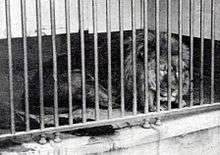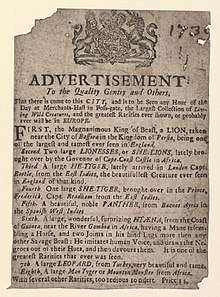Cape lion
| Cape lion | |
|---|---|
 | |
| Cape lion in Jardin des Plantes, Paris, photographed in 1860 | |
| Scientific classification | |
| Kingdom: | Animalia |
| Phylum: | Chordata |
| Class: | Mammalia |
| Order: | Carnivora |
| Suborder: | Feliformia |
| Family: | Felidae |
| Subfamily: | Pantherinae |
| Genus: | Panthera |
| Species: | P. leo |
| Subspecies: | P. l. melanochaita |
| Trinomial name | |
| Panthera leo melanochaita (Ch. H. Smith, 1842[1] | |
| Synonyms | |
|
Panthera leo capensis[2] | |
The Cape lion was a Panthera leo melanochaita population in South Africa's Natal and Cape Provinces that has been extirpated in the mid-19th century.[1][3] The type specimen originated at the Cape of Good Hope and was described in 1842.[4]
Until 2017, the Cape lion was considered a distinct lion subspecies.[5][2][6] Phylogeographic analysis showed that lion populations in Southern and East Africa are closely related.[7][8] In 2017, lion populations in Southern and East Africa were subsumed to Panthera leo melanochaita.[6]
Taxonomy
.jpg)
Felis (Leo) melanochaita was a black-maned lion specimen from the Cape of Good Hope that was described by Ch. H. Smith in 1842.[4][2] In the 19th century, naturalists and hunters recognised it as a distinct subspecies because of this dark mane colour.[1] In the 20th century, some authors supported this view of the Cape lion being a distinct subspecies.[9][10] Vratislav Mazák hypothesized that it evolved geographically isolated from other populations by the Great Escarpment.[1]
This theory was questioned in the early 21st century. Genetic exchanges between lion populations in the Cape, Kalahari and Transvaal regions, and farther east are considered having been possible through a corridor between the escarpment and the Indian ocean.[7] Results of phylogeographic studies support this notion of lions in Namibia, Botswana and South Africa being genetically close.[11][12] Based on the analysis of 357 lion samples from 10 countries, it is thought that lions migrated from Southern to East Africa during the Pleistocene and Holocene.[11] Analysis of 194 lion samples from 22 different countries suggest that populations in Southern and East Africa are distinct from populations in West and North Africa and Asia.[12] In 2017, lion populations in Southern and East Africa were subsumed under P. l. melanochaita.[6]
Zoological specimens
A few natural history museums keep Cape lion specimens in their collections:
- the Transvaal Museum has a female Cape lion skull;[13]
- the Rijksmuseum van Natuurlijke Historie has two Cape lion skulls;[14]
- the Natural History Museum, London and the Paris Museum of Natural History each have a mounted Cape lion;[14]
- the Swedish Museum of Natural History has a Cape lion skull, and the Zoological Museum Amsterdam a mounted specimen.[1]
Characteristics
The type specimen of the Cape lion was described as very large with black-edged ears and a black mane extending beyond the shoulders and under the belly.[4] Skulls of two lion specimen in the British Natural History Museum from the Orange River basin were described as a little shorter in the occipital regions than other lions in South Africa and with a tendency to develop the second lower premolar.[1]
American zoologist Edmund Heller described the Cape lion's skull as longer than those of equatorial lions, by at least 1.0 in (25 mm) on average, despite being comparatively narrow. He considered the Cape lion to have been 'distinctly' bigger than other lions in Africa.[15] Lions approaching 272 kg (600 lb) were shot south of the Vaal River.[16] 19th century authors claimed that the Cape lion was bigger than the Asiatic lion.[17]
Results of a long-term study indicate that the colour of lion manes is influenced by climatic variables and varies between individuals. Manes are darker and longer in cool seasons.[18]
Distribution and habitat

In the early 19th century, lions still occurred in the Karoo plains and in the Northern Cape. In 1844, lions were sighted south of the Riet River. The last lions south of the Orange River were sighted between 1850 and 1858. In the northern Orange Free State, lions may have survived into the 1860s.[1]
In 2003, six lions from Kgalagadi Transfrontier Park were relocated to Addo Elephant National Park in the Eastern Cape Province.[19]
In captivity
In 2000, specimens asserted to be descendants of the Cape lion were found in captivity in Russia, and two of them were brought to South Africa. South African zoo director John Spence reportedly was long fascinated by stories of these grand lions scaling the walls of Jan van Riebeeck's castle in the 17th century. He studied van Riebeeck's journals to discern Cape lions' features, which include a long black mane, black in their ears, and larger size. He believed some Cape lions might have been taken to Europe and interbred with other lions. His 30-year search led to his discovery of black-maned lions closely resembling Cape lions at the Novosibirsk Zoo in Siberia, in 2000.[20][21] Besides having a black mane, the specimen that attracted Spence had a "wide face and sturdy legs." Novosibirsk Zoo's population, which had 40 cubs over a 30-year period, continues, and Spence, aided by a zoo in Vienna, was allowed to bring two cubs back to Tygerberg Zoo. Back in South Africa, Spence explained that he hoped to breed lions that at least looked like Cape lions, and also hoped to have DNA testing done to establish whether the cubs were descendants.[22] Spence died in 2010 and the zoo closed in 2012, with the lions expected to go to Drakenstein Lion Park.[23]
References
- 1 2 3 4 5 6 7 Mazak, V. (1975). "Notes on the Black-maned Lion of the Cape, Panthera leo melanochaita (Ch. H. Smith, 1842) and a Revised List of the Preserved Specimens". Verhandelingen Koninklijke Nederlandse Akademie van Wetenschappen (64): 1–44.
- 1 2 3 Wozencraft, W.C. (2005). "Panthera leo". In Wilson, D.E.; Reeder, D.M. Mammal Species of the World: A Taxonomic and Geographic Reference (3rd ed.). Johns Hopkins University Press. p. 546. ISBN 978-0-8018-8221-0. OCLC 62265494.
- ↑ Bauer, H.; Packer, C.; Funston, P.F.; Henschel, P. & Nowell, K. (2015). "Panthera leo". IUCN Red List of Threatened Species. Version 2017-1. International Union for Conservation of Nature.
- 1 2 3 Smith, C.H. (1842). "Black maned lion Leo melanochaita". In Jardine, W. The Naturalist's Library. Vol. 15 Mammalia. London: Chatto and Windus. p. Plate X, 177.
- ↑ Nowell, K.; Jackson, P. (1996). "Panthera leo". Wild Cats: Status Survey and Conservation Action Plan (PDF). Gland, Switzerland: IUCN/SSC Cat Specialist Group. pp. 17–21, 37–41. ISBN 978-2-8317-0045-8.
- 1 2 3 Kitchener, A. C.; Breitenmoser-Würsten, C.; Eizirik, E.; Gentry, A.; Werdelin, L.; Wilting, A.; Yamaguchi, N.; Abramov, A. V.; Christiansen, P.; Driscoll, C.; Duckworth, J. W.; Johnson, W.; Luo, S.-J.; Meijaard, E.; O’Donoghue, P.; Sanderson, J.; Seymour, K.; Bruford, M.; Groves, C.; Hoffmann, M.; Nowell, K.; Timmons, Z.; Tobe, S. (2017). "A revised taxonomy of the Felidae: The final report of the Cat Classification Task Force of the IUCN Cat Specialist Group" (PDF). Cat News (Special Issue 11). ISSN 1027-2992.
- 1 2 Yamaguchi, N. (2000). The Barbary lion and the Cape lion: their phylogenetic places and conservation. African Lion Working Group News 1: 9–11.
- ↑ Barnett, R.; Yamaguchi, N.; Barnes, I.; Cooper, A. (2006). "Lost populations and preserving genetic diversity in the lion Panthera leo: Implications for its ex situ conservation" (PDF). Conservation Genetics. 7 (4): 507–514. doi:10.1007/s10592-005-9062-0. Archived from the original (PDF) on 2006-08-24.
- ↑ Lundholm, B. (1952). "A skull of a Cape lioness (Felis leo melanochaita H. Smith". Annals of the Transvaal Museum (32): 21–24.
- ↑ Stevenson-Hamilton, J. (1954). "Specimen of the extinct Cape lion". African Wildlife (8): 187–189.
- 1 2 Antunes, A.; Troyer, J. L.; Roelke, M. E.; Pecon-Slattery, J.; Packer, C.; Winterbach, C.; Winterbach, H.; Johnson, W. E. (2008). "The Evolutionary Dynamics of the Lion Panthera leo Revealed by Host and Viral Population Genomics". PLoS Genetics. 4 (11): e1000251. doi:10.1371/journal.pgen.1000251. PMC 2572142. PMID 18989457.
- 1 2 Bertola, L. D.; Van Hooft, W. F.; Vrieling, K.; Uit De Weerd, D. R.; York, D. S.; Bauer, H.; Prins, H. H. T.; Funston, P. J.; Udo De Haes, H. A.; Leirs, H.; Van Haeringen, W. A.; Sogbohossou, E.; Tumenta, P. N.; De Iongh, H. H. (2011). "Genetic diversity, evolutionary history and implications for conservation of the lion (Panthera leo) in West and Central Africa". Journal of Biogeography. 38 (7): 1356–1367. doi:10.1111/j.1365-2699.2011.02500.x.
- ↑ Lundholm, B. (1952). "A skull of a Cape Lioness (Felis leo melanochaitus H. Smith)". Annale van die Transvaal Museum 22(1): 21−24.
- 1 2 Mazak, V. and Husson. A.M. (1960). "Einige Bemerkungen über den Kaplöwen, Panthera leo melanochaitus (Ch. H. Smith, 1842)". Zoologische Mededelingen 37(7): 101−111.
- ↑ Heller, E. (1913). New races of carnivores and baboons from equatorial Africa and Abyssinia Smithsonian Miscellaneous Collections 61(19): 1–12.
- ↑ Pease, A. E. (1913). The Book of the Lion John Murray, London.
- ↑ Lieber, F.; Wigglesworth, E.; Bradford, T. G., eds. (1857). "Lion (felis leo)". Encyclopædia Americana. A popular dictionary. Volume VIII (New ed.). Philadelphia: Blanchard and Lea. p. 5−7.
- ↑ West P.M.; Packer C. (2002). "Sexual Selection, Temperature, and the Lion's Mane". Science. 297 (5585): 1339–1343. doi:10.1126/science.1073257. PMID 12193785.
- ↑ Hayward, M.W. and Hayward, G.J. (2007). "Activity patterns of reintroduced lion Panthera leo and spotted hyaena Crocuta crocuta in the Addo Elephant National Park, South Africa". African Journal of Ecology 45(2): 135−141.
- ↑ "'Extinct' lions (Cape lion) surface in Siberia". The BBC. 2000. Retrieved 2012-12-31.
- ↑ "Лев". Sibzoo.narod.ru. Archived from the original on March 29, 2009. Retrieved January 28, 2010.
- ↑ "South Africa: Lion Cubs Thought to Be Cape Lions". AP Archive, The Associated Press. 2000. (with 2-minute video of cubs at zoo with John Spence, 3 sound-bites, and 15 photos)
- ↑ Davis, R. (2012). "We lost a zoo: Western Cape's only zoo closes". Daily Maverick. Retrieved 2015-03-30.
See also
- Lion populations: West African lion · Central African lion · Asiatic lion · East African lion · Southern African lion · Barbary lion · Cape lion · Lions in Europe · American lion
- Wild cats in Africa: African leopard · African golden cat · Caracal · Serval · African wildcat · Sand cat · Cheetah · Black-footed cat
External links
| Wikimedia Commons has media related to Panthera leo melanochaita. |
| Wikispecies has information related to Panthera leo melanochaita |